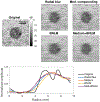Resolution and Speckle Reduction in Cardiac Imaging
- PMID: 33112742
- PMCID: PMC8034817
- DOI: 10.1109/TUFFC.2020.3034518
Resolution and Speckle Reduction in Cardiac Imaging
Abstract
Cardiac imaging depends on clear visualization of several different structural and functional components to determine left ventricular and overall cardiac health. Ultrasound imaging is confounded by the characteristic speckle texture resulting from subwavelength scatterers in tissues, which is similar to a multiplicative noise on underlying tissue structure. Reduction of this texture can be achieved through physical means, such as spatial or frequency compounding, or through adaptive image processing. Techniques in both categories require a tradeoff of resolution for speckle texture reduction, which together contribute to overall image quality and diagnostic value. We evaluate this tradeoff for cardiac imaging tasks using spatial compounding as an exemplary speckle reduction method. Spatial compounding averages the decorrelated speckle patterns formed by views of a target from multiple subaperture positions to reduce the texture at the expense of active aperture size (and, in turn, lateral resolution). We demonstrate the use of a novel synthetic aperture focusing technique to decompose harmonic backscattered data from focused beams to their aperture-domain spatial frequency components to enable combined transmit and receive compounding. This tool allows the evaluation of matched data sets from a single acquisition over a wide range of spatial compounding conditions. We quantified the tradeoff between resolution and texture reduction in an imaging phantom and demonstrated improved lesion detectability with increasing levels of spatial compounding. We performed a cardiac ultrasound on 25 subjects to evaluate the degree of compounding useful for diagnostic imaging. Of these, 18 subjects were included in both qualitative and quantitative analysis. We found that compounding improved detectability of the endocardial border according to the generalized contrast-to-noise ratio in all cases, and more aggressive compounding made further improvements in ten out of 18 cases. Three expert reviewers evaluated the images for their usefulness in several diagnostic tasks and ranked four compounding conditions ("none," "low," "medium," and "high"). Contrary to the quantitative metrics that suggested the use of high levels of compounding, the reviewers determined that "low" was usually preferred (77.9%), while "none" or "medium" was selected in 21.2% of cases. We conclude with a brief discussion of the generalization of these results to other speckle reduction methods using the imaging phantom data.
Figures













References
-
- Wagner R, Smith S, Sandrik J, and Lopez H, “Statistics of Speckle in Ultrasound B-Scans,” IEEE Transactions on Sonics and Ultrasonics, vol. 30, no. 3, pp. 156–163, 1983.
-
- Smith SW, Wagner RF, Sandrik JM, and Lopez H, “Low contrast detectability and contrast/detail analysis in medical ultrasound,” IEEE Transactions on Sonics and Ultrasonics, vol. 3, no. 3, pp. 164–173, 1983.
Publication types
MeSH terms
Grants and funding
LinkOut - more resources
Full Text Sources
Other Literature Sources

